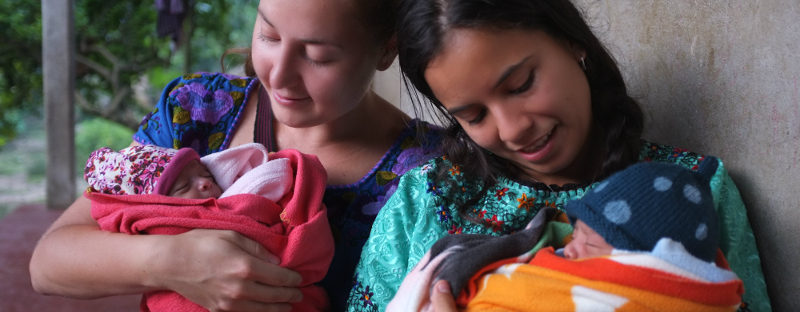by Leith Merrow Mullaly, RN, MSN, IBCLC
Sex trafficking is a form of modern slavery that exists in our own backyard. Traffickers resort to violence, threats, lies and other forms of intimidation to force both adults and children to take part in sexual acts against their will. Sex trafficking can occur anywhere, even in your very own community.
In 2016, the National Center for Missing & Exploited Children estimated that 1 in 6 endangered runaways reported to their Center were likely sex trafficking victims. The Urban Institute estimated that the underground sex economy ranged from $39.9 million in Denver, Colorado, to $290 million in Atlanta, Georgia. Prostitutes are victims of these crimes.
Yet, sadly, since 2007 the National Human Trafficking Resource Center Hotline has received only 145,764 calls* (1-888-373-7888). Why is this? Many of the victims of sex trafficking have no knowledge that such a resource even exists. To make a phone call to get help is not possible for most victims as communication is strictly controlled and monitored by the pimp who has all the power. Perhaps, we nurses should have this phone number posted in areas where women in your care can see it. Nurses should also be aware of the warning signs associated with trafficking, and when we suspect our patient/client may be such a victim, we should hand them a phone!
Commercially exploited children in our country have almost universally been sexually abused and enter prostitution with a history of complex trauma. Their families have been absent or dysfunctional. Several young women with whom I work were identified by teachers as abused (eg, a 7 year old who wouldn’t change gym clothes because of bruises all over her body). There were mixed reaction from teachers. Some did follow up with local child protective services. Some called parents. One young woman told me “My teacher was concerned but my mother denied any sexual abuse but then said ‘well, she is so suggestive around my husband’; I was 6 years old!” Many girls tried to tell an adult but many were afraid. Some shared “I have told people and nobody believed me”. Some were placed in foster homes, and believe it or not, they were molested and recruited by their pimps from the foster care system.
What can nurses do? This may seem so much bigger than what we can do as individuals. But we can develop a more acute awareness about the realities of human sex trafficking right in our own environment. When you hear or suspect human sex trafficking may be occurring to the patient sitting before you, believe them! They very frequently display a fearful, distrusting affect because many times they have tried to tell and NOT been believed. Offer them your belief. Former President Jimmy Carter wrote an editorial in the Washington Post (May 31, 2016) entitled: “Curb prostitution, punish those who buy sex rather than those who sell it”. I recommend reading this. Carter describes the “Nordic Model” which is a system that treats purchasing and profiting from sex as major serious crimes. That might be something for which nurses in small or large groups, such as an AWHONN Chapter or Section, can advocate for at their own local or state level. Just imagine the impact it could have if the men in your community who are purchasing sex were prosecuted and exposed in public as the criminals they actually are. We have heard “but he is a pastor” and “but he is on city council” and “ their reputations would be destroyed”. Women and children who are sold for sex face more than ruined reputations, they face ruined lives!
As health care providers and patient advocates we must begin to work vigorously with our own elected officials to change the unacceptable and shocking status quo. Did you know that trafficked children are treated as criminals in many jurisdictions even though under Federal law those under 18 years old are classified as victims?
My state, the Commonwealth of Virginia, was the last state in the country to pass a stand-alone human sex trafficking law (2015). Now, anyone assisting, or working to traffic, sell or purchase prostitution can be arrested and charged. This law came about because of the incredible tenacity and diligent work of a very few advocates working with their local legislators. They provided both Representatives and their constituents with education on this issue.
Health education has always been a strong focus for nurses. The public looks to us to educate them and the public trusts nurses to provide solid, honest information. My “own public” sat in disbelief when we first started talking about sex trafficking right here where we live and work. I heard comments like “No way, this is a lovely community. Not here!” As they learned the realities they were initially horrified, but now are very energized to help in any number of ways. We also can’t forget to educate parents. They need to know that when young teens, girls and boys, meet other “youth” on the internet they are often opening themselves to traffickers. When middle and high school kids sext and post photos they can and do become easy prey to predators.
If your community doubts the very idea of sex trafficking in your town, send them to a website called “Backpage”. It is a trafficking website that lists ads for prostitution. In my small size city there are more than 20 ads a day! “Plenty of Fish” is another site that purports to be a dating site. We have had some of our trafficked victims “hooked up” on this site with “clients” purchasing sex. If a nearly naked woman is advertising to come to a hotel room to provide a “massage”, read between the lines. If the face is blurred, it most likely means the girl is a young minor. If you look…unfortunately you will find human sex trafficking right in your own backyard.
Overwhelmingly the young women with whom I work had dreams of growing up to be moms or lawyers or teachers or doctors or nurses. One girl had seriously and sincerely wanted to be an astronaut. No one ever dreamed of growing up to be a prostitute! They were brought into the “life style” as young minors. They did not choose the life and do NOT benefit financially (a common misconception). Once used, these victims are humiliated, shamed, embarrassed and trapped in a system they despise but have no idea how to escape. Many seem to know of a girl who tried to escape who either “disappeared” or who was re-captured with her photo posted on line with her head shaved and tattooed by her pimp.
NURSES CAN MAKE A HUGE DIFFERENCE if we just start working together to:
- Learn the facts about Human Sex Trafficking in our own communities
- Work more closely with local and state law enforcement
- Provide vitally-needed education to our peers, friends, organizations and parent groups
- Advocate with legislators to enforce the law and explore alternatives such as the “Nordic Model” which is now used in Canada, France and Sweden
- Believe a patient who trusts you enough to share their situation
- Post the National Human Trafficking Resource Center Hotline – 1-888-373-7888—in a visible location in your setting
- Be hyper-alert to telltale signs such as :
- Tattoos or branding
- Very unclear past history and no stable address
- STD’s, especially repeated episodes
- Wearing scanty clothes – often 2 sizes too small
- Presence of cotton or debris in vagina and/ or rectum
- Problems with jaw or neck
- Inability to keep appointments
- No identification
- Accompanied by a person who does not allow the patient to speak or does not want to leave them alone during interview and/or care
- Inconsistent stories (conflicting stories or misinformation)
- Lack of documentation of age- appropriate immunizations and health care encounters
There are 3 million nurses in our country. I believe that together we have the power to change hearts and minds so that our local communities and our nation understand the realities of human sex trafficking. I serve on the Foundation Board of a home for victims. Our motto is: “Changing one life at a time and changing the world for future generations”. I have seen the first goal come true with individual young women. Won’t you join me in meeting both goals?
AWHONN believes Nurses are ideally positioned to screen, identify, care for, provide referral services for, and support victims of human trafficking. Therefore, the Association of Women’s Health, Obstetric and Neonatal Nurses (AWHONN) supports improved education and awareness for nurses regarding human trafficking. Learn more about AWHONN’s position on this critical topic.
Resources:
References
*Number of calls reported to the Human Trafficking Hotline as of December 2016 for more information visit https://humantraffickinghotline.org/
Estimating the Size and Structure of the Underground Commercial Sex Economy in Eight Major US Cities
National Center for Missing & Exploited Children
 Leith Merrow Mullaly, RN, MSN, IBCLC
Leith Merrow Mullaly, RN, MSN, IBCLC
Leith Mullaly is a past president of AWHONN and has served at all levels of the organization. Leith has a passion for both nursing and the specialty of Women’s Health and Newborn care. Her focus within AWHONN has always been to mentor future leaders and encourage nurses’ participation in their professional association. She has experience as a Staff Nurse, Staff Educator, MCH Director, Clinical Faculty Member, Certified Lactation Consultant and Author. She is a nationally ranked speaker on topics such as Postpartum Depression, Breastfeeding, the Image of Nursing, Service Excellence, Perinatal Loss and Bereavement, Mature Primiparas. Her interest in care for Victims of Human Sex Trafficking has been a major focus for the past several years.



 Karin Beschen is a Licensed Mental Health Counselor specializing in reproductive and maternal mental health. She also serves as a volunteer co-coordinator for Iowa for Postpartum Support International.
Karin Beschen is a Licensed Mental Health Counselor specializing in reproductive and maternal mental health. She also serves as a volunteer co-coordinator for Iowa for Postpartum Support International.
 Evgeniya Larionova received her Bachelors of Science in Nursing from MGH Institute of Health Professions. She is a founder and an Artistic Director of AMGITS Drama&Poetry Club at the Boston Living Center. She is a member of the student Leadership Committee of the Harvard Medical School Center for Primary Care. Evgeniya is passionate about infectious diseases, community health and integrating holistic care in modern practices. In her spare time she plays in the Russian theater, enjoy reading, playing the guitar and hiking.
Evgeniya Larionova received her Bachelors of Science in Nursing from MGH Institute of Health Professions. She is a founder and an Artistic Director of AMGITS Drama&Poetry Club at the Boston Living Center. She is a member of the student Leadership Committee of the Harvard Medical School Center for Primary Care. Evgeniya is passionate about infectious diseases, community health and integrating holistic care in modern practices. In her spare time she plays in the Russian theater, enjoy reading, playing the guitar and hiking.


 Lori is a neonatal nurse that has made her way to Sweden. She is also a Yoga Alliance Certified Yoga Teacher and Certified Prenatal/Postnatal Yoga Teacher. Follow her adventures working and traveling through Europe in her blog, Neonurse, or on Instagram.
Lori is a neonatal nurse that has made her way to Sweden. She is also a Yoga Alliance Certified Yoga Teacher and Certified Prenatal/Postnatal Yoga Teacher. Follow her adventures working and traveling through Europe in her blog, Neonurse, or on Instagram. Leith Merrow Mullaly, RN, MSN, IBCLC
Leith Merrow Mullaly, RN, MSN, IBCLC
 We go in to a completely bare room and make it a functioning OR.
We go in to a completely bare room and make it a functioning OR.  Cecille, describe your work educating midwives in Guatemala
Cecille, describe your work educating midwives in Guatemala
 Where to next?
Where to next?

 Dr. Ashley Hodges is an Associate Professor and Assistant Dean for Graduate Clinical Programs at the University of Alabama at Birmingham School of Nursing. She is certified as a Women’s Health Nurse Practitioner and has over 25 years of experience in maternal child nursing, administration and nursing education. She was recently named in the Top 20 Outstanding Professors of Women’s Health Nursing by Nurse Practitioner Schools. Dr. Hodges served a two-year term as Board Member for AWHONN beginning in 2014 and was the 2015 Chair of the Public Policy Committee. She is currently a member of the editorial advisory board for the journal Nursing for Women’s Health.
Dr. Ashley Hodges is an Associate Professor and Assistant Dean for Graduate Clinical Programs at the University of Alabama at Birmingham School of Nursing. She is certified as a Women’s Health Nurse Practitioner and has over 25 years of experience in maternal child nursing, administration and nursing education. She was recently named in the Top 20 Outstanding Professors of Women’s Health Nursing by Nurse Practitioner Schools. Dr. Hodges served a two-year term as Board Member for AWHONN beginning in 2014 and was the 2015 Chair of the Public Policy Committee. She is currently a member of the editorial advisory board for the journal Nursing for Women’s Health. 